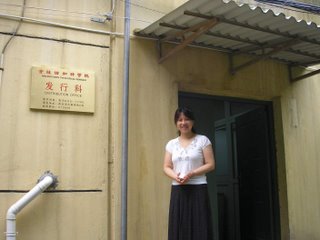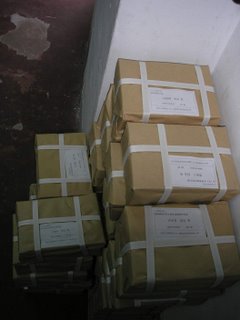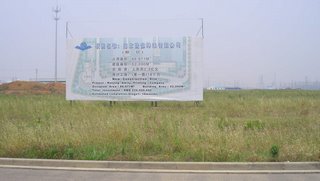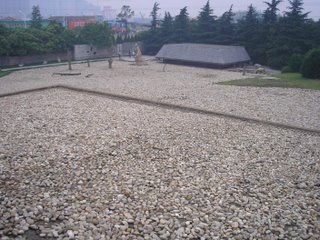

While we were interested in the printing process, we particularly wanted to understand how the printed Bibles finally reached the local populations. Considering the religious restrictions of the past in China, we were anxious to see evidence that Bibles printed by Amity reached people who wanted one. Well, that is the story we want share with you, the reader of this blog.
Nanjing is only three hours away by train from Shanghai and we were rather pleased that the railway station was just one block away from our Shanghai hotel. Faye was again very helpful and arranged for a couple of porters to get our luggage on the train, which, by the way, was chocka full. As we traveled through China we learned that China railways do not have 1st and 2nd class seating. Instead, we traveled on 'soft seats', the equivalent of 1st class. Interesting, isn't it? The other class of seating is 'hard seats'. Our journey on 'soft seats' was therefore comfortable enough and we arrived in Nanjing about 30 minutes after the scheduled arrival time. Peter Dean, an expatriate New Zealander and who is attached as a special consultant to Amity Press, was waiting for us. We really appreciated that. Actually, after a month of travel in China, it was rather weird to have a non Chinese driving us and Peter did an excellent job of weaving us through the Nanjing traffic.
Peter and his wife Jane live at the Press and kindly offered hospitality to us. We very much appreciated this as it gave us time to share about the work of Bible printing and distribution as well as just having quiet fellowship together.
The morning after our arrival I walked into the press and the first thing that struck me was the respect workers showed for the 'product' - the Holy Bible, as it was put together:
 But the whole process begins much further afield. The success of effective printing and distribution of Scriptures depends on the availability of Bible paper financed by Christians from around the world. It begins with local congregations from all over the world:
But the whole process begins much further afield. The success of effective printing and distribution of Scriptures depends on the availability of Bible paper financed by Christians from around the world. It begins with local congregations from all over the world: Bible paper is produced in China (like all commodities, so it seems) and is purchased with the donated dollar received from you and me and the vast Bible loving family throughout the world!
Bible paper is produced in China (like all commodities, so it seems) and is purchased with the donated dollar received from you and me and the vast Bible loving family throughout the world! So, what were the outstanding memories of our visit to Amity Press?
So, what were the outstanding memories of our visit to Amity Press?# Unquestionably, to see the printing presses pouring out Bibles by the thousand each day:

 # To see the care that was taken by Amity workers to produce the best possible product:
# To see the care that was taken by Amity workers to produce the best possible product: # The obvious enjoyment of people as they worked together:
# The obvious enjoyment of people as they worked together: # The use of the latest technology and equipment like this automatic sewing machine:
# The use of the latest technology and equipment like this automatic sewing machine: Carol was nevertheless intrigued by the older method of sewing Bible books together:
Carol was nevertheless intrigued by the older method of sewing Bible books together:
At one time, while I was still working with BS Australia, I had wondered about Amity printing Bibles for the Australian market, but considered that at that time there was still a way to go before quality standards reached our market expectation. To see the fine work now being done was indeed a great thrill. Leather editions with gilding and thumb-indexing are produced to a very high standard. This manual process is tedious and requires a lot of concentration:
1. Marking the index page:
 2. Punching the thumb index:
2. Punching the thumb index: 3. Inserting the tabs:
3. Inserting the tabs: 4. The gilding was done in house with good results:
4. The gilding was done in house with good results: And have a look at the finished product ready to be shipped out:
And have a look at the finished product ready to be shipped out:
 In addition to Bibles, we were delighted to see other initiatives that included Luke's Gospel (in English & Chinese) together with the Jesus Video (DVD) for free distribution in China:
In addition to Bibles, we were delighted to see other initiatives that included Luke's Gospel (in English & Chinese) together with the Jesus Video (DVD) for free distribution in China: One book that also delighted was a publication of a series of Bible readings under the title of 'The Words of Jesus - Herbal Tea for the Spirit'. This is an edition published by the Government Ministry of Religion & Culture:
One book that also delighted was a publication of a series of Bible readings under the title of 'The Words of Jesus - Herbal Tea for the Spirit'. This is an edition published by the Government Ministry of Religion & Culture:

Click on the images above and below and read for yourself a couple examples of the text in this fine publication.
 Being in both English and Chinese, the publication also admirably supports the aim for people in China to learn English. We observed that learning English is very much a big thing in China. I think we may have mentioned in the Shanghai chapter that the Bible is recommended reading in the Shanghai area because of its value as a 'learning English' tool. It would seem that Herbal Tea for the Spirit fits that category and at the same time, and let me quote from the book's preface, "Will help the believers to have a better grasp and knowledge of the sayings of Jesus and serve as an easy and useful access to the general public for better understanding the Christian moral ideals."
Being in both English and Chinese, the publication also admirably supports the aim for people in China to learn English. We observed that learning English is very much a big thing in China. I think we may have mentioned in the Shanghai chapter that the Bible is recommended reading in the Shanghai area because of its value as a 'learning English' tool. It would seem that Herbal Tea for the Spirit fits that category and at the same time, and let me quote from the book's preface, "Will help the believers to have a better grasp and knowledge of the sayings of Jesus and serve as an easy and useful access to the general public for better understanding the Christian moral ideals."Many have asked how the Scriptures are distributed in China. The fact that some 47 million Bibles have been printed since Amity Press commenced printing in 1987 has not always assured donors that everyone in China who would like a Bible, can obtain one. From listening to many who know China much better than ourselves, we understand that in the past there were restrictions and perhaps there are still some restrictions in some parts of China. What we can tell you is what we observed and found out for ourselves.
We visited one of the Distribution Centres in Nanjing
 and spoke to the lady responsible for the Distribution Office about how people can best obtain a Bible. She told us that the centre receives requests for Bibles from both churches and individuals.
and spoke to the lady responsible for the Distribution Office about how people can best obtain a Bible. She told us that the centre receives requests for Bibles from both churches and individuals. These requests are processed at this centre, as well as in another 69 distribution centres throughout China. Single and small multiple orders are forwarded to the requesting parties through China Post, even to the point where China Post will collect postage at the receiving end. As we walked around the centre, I noticed a quantity of individually addressed parcels waiting to be collected:
These requests are processed at this centre, as well as in another 69 distribution centres throughout China. Single and small multiple orders are forwarded to the requesting parties through China Post, even to the point where China Post will collect postage at the receiving end. As we walked around the centre, I noticed a quantity of individually addressed parcels waiting to be collected: Peter Dean also told us of Bibles being sent direct from Amity Printing Company
Peter Dean also told us of Bibles being sent direct from Amity Printing Company  to individuals as well as to the 69 distribution centres throughout China. Once again, China Post takes care of delivering the small orders
to individuals as well as to the 69 distribution centres throughout China. Once again, China Post takes care of delivering the small orders
This Van is full of Braille Bibles which are delivered free of charge by China Post to blind people:

 The demand for Scriptures is very high and Amity Press is printing to capacity. For that reason, an ambitious plan is well underway to substantially increase production by building a new printing press at a different location:
The demand for Scriptures is very high and Amity Press is printing to capacity. For that reason, an ambitious plan is well underway to substantially increase production by building a new printing press at a different location:
 Our prayer is that this great plan will be wonderfully blessed and that the Scriptures will come to life to all who read it.
Our prayer is that this great plan will be wonderfully blessed and that the Scriptures will come to life to all who read it.A FINAL ACTIVITY:
Our last activity in China was to visit the memorial to about 300,000 Chinese people brutally murdered by the Japanese Army in 1937. In our story above, we told you about the publication of 'Herbal Tea for the Spirit' that includes pages about Jesus teaching on 'forgiveness'. We were both staggered by the enormity of the Nanjing massacre and in the context of forgiveness identified with the Chinese people and how hard it must be to forgive. Yet, this is what Herbal Tea for the Spirit identifies in order to make peace. May those who read these words from Scripture, find that peace.
The memorial is most dramatic, right from the entry into the memorial gardens:

 This is one of many plaques that we encountered around the site and tells the story of what happened in 1937:
This is one of many plaques that we encountered around the site and tells the story of what happened in 1937: The site of this memorial is in fact a huge mass grave where countless numbers were interred. We found it interesting that it was the Red Swastika Society - a Nazi version of the Red Cross, and the Benevolent Society that organised the mass burial of the bodies. Considering that some 300,000 were massacred, it was a massive and grizzly task. The next photo is in fact an overview of the site:
The site of this memorial is in fact a huge mass grave where countless numbers were interred. We found it interesting that it was the Red Swastika Society - a Nazi version of the Red Cross, and the Benevolent Society that organised the mass burial of the bodies. Considering that some 300,000 were massacred, it was a massive and grizzly task. The next photo is in fact an overview of the site: We are heading to the buildings in the background that was the start of a shrine and museum of the happenings here. When we got there, we were profoundly moved by a section of the grave that was exposed to dramatically demonstrate what transpired here almost seventy years ago:
We are heading to the buildings in the background that was the start of a shrine and museum of the happenings here. When we got there, we were profoundly moved by a section of the grave that was exposed to dramatically demonstrate what transpired here almost seventy years ago: We read with ongoing interest the events in 1937 and left in a pensive mood.
We read with ongoing interest the events in 1937 and left in a pensive mood.It is time to go home. Our Nanjing visit added significantly to our China experience. We realise that we experienced only a tiny bit of China but are most grateful for the opportunity to understand just a little of this vast country and its people, history and culture. When we boarded our flight back to Singapore, we were pleasantly surprised to be given an upgrade to Business Class and thoroughly enjoyed the comfort and the better dining experience:

1 comment:
very cool Grampa, but in the second last photo are they bones? it really did look like you had a realy great time over in China
Post a Comment